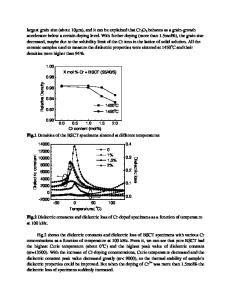Microwave dielectric properties of MO-La 2 O 3 -TiO 2 (M = Ca, Sr, Ba) ceramics
- PDF / 188,112 Bytes
- 6 Pages / 612 x 792 pts (letter) Page_size
- 43 Downloads / 460 Views
zholil Mohanan Department of Electronics, Cochin University of Science and Technology, Cochin 682 022, India (Received 29 January 2002; accepted 3 September 2002)
Single-phase polycrystalline ceramics in the MO–La2O3–TiO2 (M ⳱ Ca, Sr, Ba) system, such as cation-deficient hexagonal perovskites CaLa4Ti4O15, SrLa4Ti4O15, BaLa4Ti4O15, and Ca2La4Ti5O18 and the orthorhombic phases CaLa4Ti5O17 and CaLa8Ti9O31, were prepared through the solid-state ceramic route. The phases and structure of the ceramics were analyzed through x-ray diffraction and scanning electron microscopy. The microwave dielectric properties of the ceramics were studied using a network analyzer. The investigated ceramics show high ⑀r in the range 42 to 54, high quality factors with Q × f in the range 16,222 to 50,215 GHz, and low f in the range −25 to +6 ppm/°C. These high dielectric constant materials with high Q × f up to 50,215 GHz are suitable for applications where narrow bandwidth and extremely low insertion loss is necessary, especially at frequencies around 1.9 GHz.
I. INTRODUCTION
The dramatic advancements during the last two decades in the microwave integrated circuit technology have brought a revolution in telecommunication systems. Dielectric resonators (DRs) provide a compact, low-cost, and highly reliable choice as resonator elements in microwave circuits, and they now replace the conventional metallic cavity and microstrip resonators more frequently than ever before. The size of the microwave circuit is inversely proportional to the square root of its dielectric constant. The constraints due to size, frequency of operation, frequency stability, and selectivity allow only those materials with high dielectric constant (20–100), high Q factor (>2000), and low temperature coefficient of resonant frequency (f < ±20 ppm/°C) for DR applications. Most of the commercial DRs available at present fall into two groups: (i) ceramics with low dielectric constant (20 < ⑀r < 40) and high Q factor (Q × f > 50,000 GHz) such as Ba(Mg1/3Ta2/3)O3, Ba(Zn1/3Ta2/3)O3, their solidsolution modifications, Ba2Ti9O20, (Zr,Sn)TiO4, etc.; (ii) ceramics with high dielectric constant (>65) and low Q factor (Q × f < 10,000), such as the tungsten–bronze type materials in the BaO–RE2O3–TiO2 system. Though high dielectric constant materials can give better miniaturization, the applications requiring narrow bandwidth and
a)
e-mail: [email protected]
3084
http://journals.cambridge.org
J. Mater. Res., Vol. 17, No. 12, Dec 2002 Downloaded: 02 Dec 2014
extremely low insertion loss (0.3 dB) enables the use of ceramics having even ⑀r ⳱ 38.1 Dielectric materials with ⑀r > 40 and Q × f > 45,000 GHz can allow for further miniaturization of the devices without much compromise in quality. Materials with ⑀r in the range 40 to 65 suitable for such applications are few, and the search for such materials is one of the current areas of research in microwave dielectrics. The Ba5Nb4O15type cation-deficient hexagonal perovskites are characterized by high dielectric constant and high
Data Loading...











